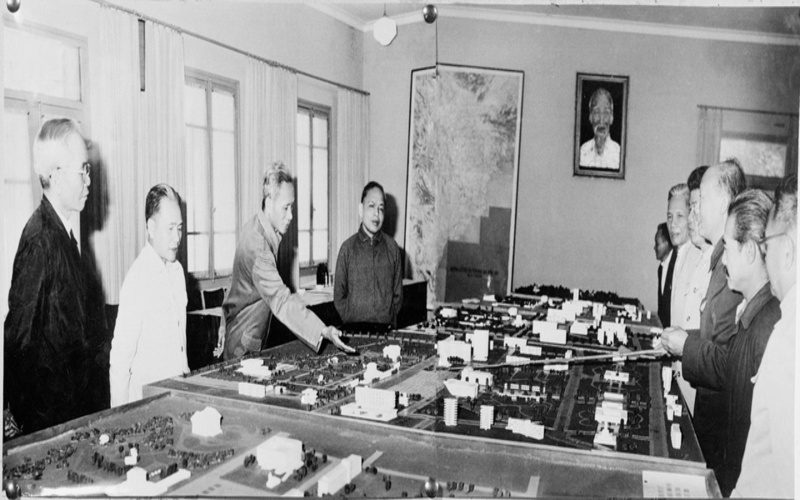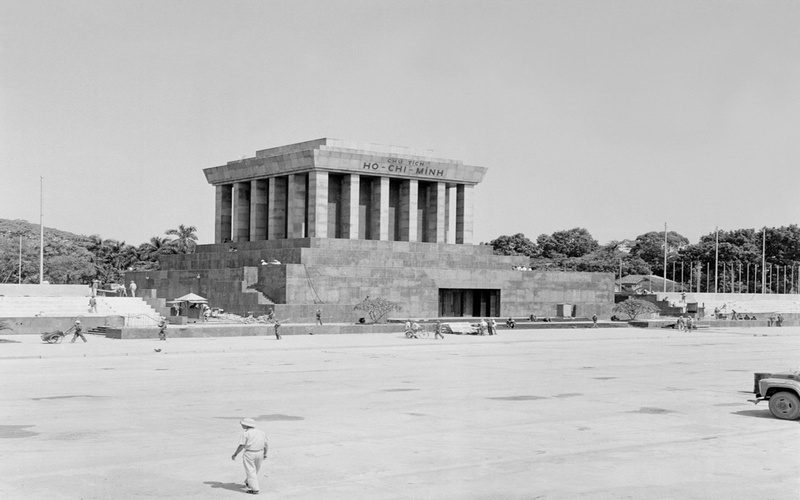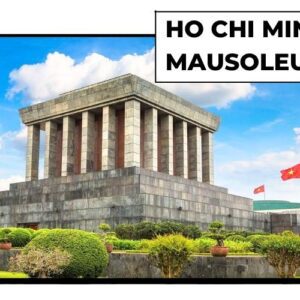
Ho Chi Minh Mausoleum is one of the important historical attractions of Hanoi city. This is the resting place of the great old father of the Vietnamese nation: President Ho Chi Minh. Coming to the Presidential Mausoleum, you not only have the opportunity to learn about his life and revolutionary activities but also explore many outstanding relics associated with the glorious history of Vietnam. Follow this article to get more useful information if you plan to visit this sacred place in the capital of Vietnam.
Where is Ho Chi Minh Mausoleum Located?
Ho Chi Minh Mausoleum was built in the old station platform in the middle of Ba Dinh Square, where President Ho Chi Minh used to chair important meetings.
Address: No. 2 Hung Vuong, Dien Bien Ward, Ba Dinh District.
Essential Information for Tourists
Ho Chi Minh Mausoleum Opening hours
Ho Chi Minh Mausoleum is open every morning on Tuesdays, Wednesdays, Thursdays, Saturdays, and Sundays. Only Mondays, Fridays, and afternoons will not take place in the visitation ceremony. The Mausoleum will still be open on special days such as the 1st of the Lunar New Year, May 19 (Uncle’s birthday), and September 2 (National Day) which fall on a Monday or Friday.
Normally, the mausoleum will be closed for about 2 months a year for renovation. The time to close for reception and visitation is usually from September to November every year.
Opening hours to visit Ho Chi Minh Mausoleum:
Hot season (from April 1 to October 31 every year)
- Opening hours: from 7:30 to 10:30
- Saturday, Sunday, and public holidays: from 07:30 to 11:00
Cold season (from November 1 to March 31 of the following year)
- Opening hours: from 8:00 to 11:00
- Saturday, Sunday, and public holidays: from 8:00 to 11:30
Entrance fee
It is completely free for Vietnamese people to visit Ho Chi Minh Mausoleum. However, as a foreigner, the ticket price to visit the Mausoleum is 25,000 VND/person, and the ticket to the stilt house is 25,000 VND/person.
History and Signification of Ho Chi Minh Mausoleum
History of formation
According to his will, President Ho Chi Minh wanted to be cremated, and his ashes scattered in three regions of the country after his death, but according to the Vietnamese people’s wishes, the Government decided to keep his body intact and place it in the Mausoleum so that everyone can have the opportunity to visit and commemorate him.
In January 1970, there is a meeting between the Governments of the Soviet Union and Vietnam to discuss the design and construction techniques of the Mausoleum. The Lenin Mausoleum in Moscow is the inspiration for the design of the current Ho Chi Minh Mausoleum.

The Governments of the Soviet Union and Vietnam meet to discuss the design and construction techniques of the Mausoleum
In February, September 1973, the groundbreaking ceremony for the construction of the Mausoleum officially took place.

The groundbreaking ceremony for the construction of the Mausoleum officially took place
On May 19, 1975, Ho Chi Minh Mausoleum was inaugurated in the air with the joy of the whole country.

Ho Chi Minh Mausoleum was inaugurated
The signification of Ho Chi Minh Mausoleum
Even though many years have passed since the country started rebuilding, Ho Chi Minh Mausoleum has always been a historical and cultural symbol of Hanoi in particular and the country of Vietnam in general. This work is the sound of deep hearts, expressing the people’s faith and love for the leader of the nation. Until now, Ho Chi Minh Mausoleum has attracted many generations of domestic and foreign tourists to visit and commemorate it every year.
Main Highlights in Mausoleum Complex
Besides the main President’s Mausoleum, you’ll also have the opportunity to explore the relics in the mausoleum area to better understand his life and revolutionary activities during the war. Here are some outstanding attractions for your reference:
Ba Dinh Square

Ba Dinh Square
Ba Dinh Square is one of the most historic relics in Hanoi. Located right in front of the Ho Chi Minh Mausoleum, this place has kept many important events in the history of Vietnam. In particular, on September 2, 1945, President Ho Chi Minh used this square to read the Declaration of Independence giving birth to the Democratic Republic of Vietnam.
Ho Chi Minh Museum
To celebrate President Ho Chi Minh’s 100th birthday, the Government of Vietnam decided to build the Ho Chi Minh Museum in the Mausoleum Complex. This place is on the list of major museums that are important to the history and culture of Vietnam. The museum campus is up to 18,000 square meters, which is a place to display thousands of preserved and precious artifacts related to the life and revolutionary path of President Ho Chi Minh.

Ho Chi Minh Museum
Ho Chi Minh’s Stilts House
This house on stilts was built according to the wish of Uncle Ho to have a Viet Bac stilt house. The current stilts house is located in the garden of the Presidential Palace, next to the fishpond and green garden. The house is very idyllic, in harmony with nature, with the ethnic stilt house architecture. This place still keeps a lot of historical items associated with President Ho Chi Minh, including a bed, table, chair, bookshelf, typewriter, etc.

Ho Chi Minh’s House on stilts
Hanoi Presidential Palace
Designed and built in the years from 1901 to 1906 by the famous French architect, Auguste Henri Vildieu, the Presidential Palace has always been a tourist attraction that attracts many visitors to admire when visiting Ho Chi Minh Mausoleum. The splendid Presidential Palace was originally built for the Governor General of Indochina. Designed in the typical French architectural style, the three-story building appears in a brilliant yellow color surrounded by fresh orchards, sightseeing roads, and carp ponds.

Hanoi Presidential Palace
House No.54
House No.54 was the living and working place of President Ho Chi Minh from December 1954 to May 1958. It has three rooms. The room adjacent to the fishpond is the office. In the middle is the dining room and finally the bedroom. Currently, in the monument of House No.54, all the living utensils of Uncle Ho are still preserved, from the documents, books, and newspapers he read to the souvenirs from international friends.

House 54
One Pillar Pagoda
One Pillar Pagoda is an ancient temple in Vietnam built during the reign of King Ly Thai Tong. It was originally named Lien Hoa Dai, which means Lotus, with a unique architecture: a shrine placed on a single pillar in the middle of Linh Chieu Lake. Currently, this relic is located next to the complex of Ba Dinh Square and Ho Chi Minh Mausoleum. If you have the opportunity to visit Uncle Ho’s mausoleum, you should not miss this unique pagoda.

One Pillar Pagoda – Hanoi
Getting to Ho Chi Minh Mausoleum
Owning one of the prime locations in the downtown area, there are many ways for you to visit Ho Chi Minh Mausoleum. You can use public transport or for more convenience, you can rent a private car. If you like freedom, you even ride a motorbike to explore the Mausoleum on your own.
By bus
This is the cheapest and most popular form of transportation in the city area. Buses to Ho Chi Minh Mausoleum have many routes depending on the location you take, each location will have different bus numbers.
Bus numbers 09, 22, 45, and 50 are routes that will move through Ho Chi Minh Mausoleum. However, if you are planning to visit, you should find out in advance the information about the departure time and the travel route of the buses to avoid being late or stopping at the wrong parking spot.
By taxi/private car
This is a faster and more convenient way to travel than taking a bus. In Hanoi, you can easily catch a taxi on the road, or you can directly contact the switchboards of major taxi companies in Vietnam to pick you up at a waiting point. However, these taxis will mainly operate in the form of on-demand pickup and drop-off. Therefore, if you want to explore more in the city, the easiest way is to rent a private car. The car will pick up and drop off and move to any attractions in the center at your request. Besides, the drivers are usually knowledgeable people about Hanoi, so they are always happy to become your guide to help you know more interesting information about the capital such as history, culture, people and food, etc. Contact us for more information.
By motorbike
Another form of transportation that is very popular for traveling in the city is motorbikes. Owning a small size, a motorbike easily moves through the streets of the capital, in addition, it also helps you to overcome the roads that are often congested during rush hour traffic. However, when using this form, you should pay attention to traffic rules on key roads to avoid unnecessarily bad cases.
Rules to Remember when Visiting the Mausoleum
- Clothing: Dress neatly and politely, not wearing skirts that are too short or revealing, or offensive in nature.
- Attitude: Gentle, walk softly, speak softly without causing disorderly noise, and line up in order when entering the mausoleum. When entering the Mausoleum, you should remove your hat and don’t put your hands in your pockets.
- Device: You can bring phones and cameras, but you are not allowed to take pictures or record in prohibited areas, especially inside the mausoleum.
- Children from 3 years old and above are only allowed to enter the Mausoleum.
If you are a history buff, Ho Chi Minh Mausoleum is a must-visit destination during your trip to Hanoi. This historic destination will help you extend your knowledge about the history as well as the unique cultural features in the life of the Vietnamese. In addition, Hanoi owns many spots that you should visit, such as the Imperial Citadel, Temple of Literature, Hoa Lo Prison Museum, Hoan Kiem Lake, etc. Don’t hesitate to contact us if you wish to organize a tailor-made trip to this beautiful city.
Read more:




